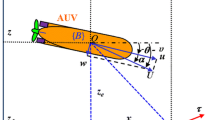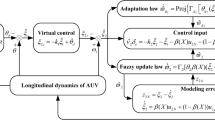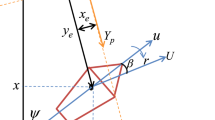Abstract
Computed-torque controller plus fuzzy inverse desired trajectory compensation technique based on robust adaptive fuzzy observer is proposed to control underwater vehicle subject to uncertainties. A fuzzy inverse desired trajectory compensator is developed as a nonlinear filter at input trajectory level outside the control loop to address the issue of unavailable normalizing factor. A robust adaptive state observer with loose constraint on the position of the uncertainty function is proposed to evaluate the unavailable states. Numerical simulation results of regulation performance demonstrate that the observer solves the problem of strict constraint conditions on position uncertainties. Comparisons of tracking performance between the proposed control method and computed-torque controller are performed. The results confirm that compensation at the input trajectory offers better position tracking performance and easier practical implementation than other fuzzy compensation techniques at joint torque level. The proposed control approach is simulated and its efficiency is validated through the simulation of an underwater vehicle.


















Similar content being viewed by others
References
Khalid I, Arshad MR, Syafizal I (2014) A hybrid-driven underwater glider model, hydrodynamics estimation, and an analysis of the motion control. Ocean Eng 81:111–129
Fossen TI (2002) Marine control systems: guidance, navigation and control of ships, rigs and underwater vehicles. Marine Cybernetics AS, Trondheim
Yuh J (2000) Design and control of autonomous underwater robots: a survey. Autonomous Robots 8:7–24
Zhang MJ, Chu ZZ (2012) Adaptive sliding mode control based on local recurrent neural networks for underwater robot. Ocean Eng 45:56–62
Miao BB, Li TS, Luo WL (2013) A DSC and MLP based robust adaptive NN tracking control for underwater vehicle. Neurocomputing 111:184–189
Fang MC, Wang SM, Wu MC, Lin YH (2015) Applying the self-tuning fuzzy control with the image detection technique on the obstacle-avoidance for autonomous underwater vehicles. Ocean Eng 93:11–24
Behdad G, Saeed RN (2015) Nonlinear suboptimal control of fully coupled non-affine six-DOF autonomous underwater vehicle using the state-dependent Riccati equation. Ocean Eng 96:248–257
Vinoth V, Singh Y, Santhakumar M (2014) Indirect disturbance compensation control of a planar parallel (2-PRP and 1-PPR) robotic manipulator. Robot Comp Integr Manuf 30(5):556–564
Chen Y, Ma GY, Lin SX, Gao J (2012) Adaptive fuzzy computed-torque control for robot manipulator with uncertain dynamics. Int J Adv Rob Syst 9:201–209
Liang J, Chen L (2010) Fuzzy logic adaptive compensation control for dual-arm space robot based on computed torque controller to track desired trajectory in inertia space. Gongcheng Lixue/Eng Mech 27(11):221–228
Wu DS, Gu HB, Li P (2011) Adaptive fuzzy control of Stewart platform under actuator saturation. World Acad Sci Eng Technol 60:680–684
Imani B, Ghanbari A, Noorani SS (2013) Modeling, path planning and control of a planar five-link bipedal robot by an adaptive fuzzy computed torque controller (AFCTC). In: International Conference on Robotics and Mechatronics, ICRoM 2013, pp 49–54
Song ZS, Yi JQ, Zhao DB, Li XC (2005) A computed torque controller for uncertain robotic manipulator systems: fuzzy approach. Fuzzy Sets Syst 154:208–226
Feng W, Postlethwaite A (1993) Simple robust control scheme for robot manipulators with only joint position measurements. Int J Robot Res 12(5):490–496
Masoud M, Mostafa G, Mohammad JS (2012) A nonlinear high gain observer based input-output control of flexible link manipulator. Mech Res Commun 45:34–41
Zeng W, Wang C (2014) Learning from NN output feedback control of robot manipulators. Neurocomputing 125:172–182
Boulkroune A, Tadjine M, M’Saad M, Farza M (2014) Design of a unified adaptive fuzzy observer for uncertain nonlinear systems. Inf Sci 265:139–153
Li CY, Tong SC, Wang W (2011) Fuzzy adaptive high-gain-based observer backstepping control for SISO nonlinear systems. Inf Sci 181:2405–2421
Boulkroune A, Bounar N, M’Saad M, Farza M (2014) Indirect adaptive fuzzy control scheme based on observer for nonlinear systems: a novel SPR-filter approach. Neurocomputing 135:378–387
Li YM, Du YJ (2012) Indirect adaptive fuzzy observer and controller design based on interval type-2 T-S fuzzy model. Appl Math Model 36:1558–1569
Boulkroune A, M’saad M (2012) On the design of observer-based fuzzy adaptive controller for nonlinear systems with unknown control gain sign. Fuzzy Sets Syst 201:71–85
Wu TS, Karkoub M, Chen HS, Yu WS, Her MG (2015) Robust tracking observer-based adaptive fuzzy control design for uncertain nonlinear MIMO systems with time delayed states. Inf Sci 290:86–105
Le TD, Kang HJ, Suh YS, Ro YS (2013) An online self-gain tuning method using neural networks for nonlinear PD computed torque controller of a 2-dof parallel manipulator. Neurocomputing 116:53–61
Ioannou PA, Sun J (1996) Robust adaptive control. Prentice-Hall, Englewood. Cliffs, NJ
Polycarpou MM, Ioannou PA (1996) A robust adaptive nonlinear control design. Automatica 32(3):423–427
Wang LX (1992) Fuzzy systems are universal approximators, IEEE International Conference on Fuzzy Systems, San Diego, CA, USA, pp 1163–1170
Wang LX (1993) Stable adaptive fuzzy control of nonlinear systems. IEEE Trans Fuzzy Syst 1(2):146–149
Lewis FL, Dawson DM, Abdallah CT (2004) Robot manipulator control: theory and practice. Marcel Dekker, New York
Corless M, Leitmann G (1996) Exponential convergence for uncertain systems with componentwise bonded controllers. Springer, New York
Acknowledgments
Grateful acknowledgement is given to the financial supports from the National Natural Science Foundation of China with Grant No. 51375264 and Science and Technology Major Project of Shandong Province with Grant No. 2015JMRH0218. This work was also partially supported by State Key Laboratory of Robotics and System (HIT) with Grant No. SKLRS-2015-MS-06, and China Post-doctoral Science Foundation with Grant No. 2014T70632 and 2013M530318, and Research Awards Fund for Excellent Young and Middle-aged Scientists of Shandong Province with Grant No. BS2013ZZ008.
Author information
Authors and Affiliations
Corresponding author
Appendices
Appendix 1: Dynamic modeling of underwater vehicle
The inertia matrix \(M\) is divided into the rigid-body inertia \(M_{\text{RB}}\) and the hydrodynamic added inertia \(M_{\text{A}}\). The rigid-body inertial matrix, \(M_{\text{RB}}\), expresses the inertial terms of the vehicle. As the underwater vehicle moves in water, an added inertia \(M_{\text{A}}\) is used to represent the effective mass of the surrounding fluid as the vehicle accelerates. Rigid-body and added inertia matrix can be defined as follows:
where \(m\) denotes the mass of the underwater vehicle; \(I_{3 \times 3}\) is an identity matrix; \(I_{0}\) is the inertia matrix of the vehicle; \(r_{g}^{b} = \left[ {x_{g} ,y_{g} ,z_{g} } \right]^{T}\) is the vector from the coordinate origin of the inertial frame to center of gravity; \(S\left( \lambda \right)\) is a skew-symmetric matrix, and \(A_{11} = - \left[ {\begin{array}{*{20}c} {X_{{\dot{u}}} } & 0 & 0 \\ 0 & {Y_{{\dot{v}}} } & 0 \\ 0 & 0 & {Z_{{\dot{w}}} } \\ \end{array} } \right]\), \(A_{12} = - \left[ {\begin{array}{*{20}c} 0 & 0 & 0 \\ 0 & 0 & {Y_{{\dot{r}}} } \\ 0 & {Z_{{\dot{q}}} } & 0 \\ \end{array} } \right]\), \(A_{21} = - \left[ {\begin{array}{*{20}c} 0 & 0 & 0 \\ 0 & 0 & {M_{{\dot{w}}} } \\ 0 & {N_{{\dot{v}}} } & 0 \\ \end{array} } \right]\), \(A_{22} = - \left[ {\begin{array}{*{20}c} {K_{{\dot{p}}} } & 0 & 0 \\ 0 & {M_{{\dot{q}}} } & 0 \\ 0 & 0 & {N_{{\dot{r}}} } \\ \end{array} } \right]\).
The Coriolis and centripetal matrix, \(C\left( \upsilon \right)\), is divided into rigid-body term \(C_{RB} \left( \upsilon \right)\) and hydrodynamic Coriolis and centripetal term \(C_{A} \left( \upsilon \right)\). \(C_{RB} \left( \upsilon \right)\) consists of the centripetal and Coriolis vectors of the vehicle, and \(C_{A} \left( \upsilon \right)\) represents the hydrodynamic centripetal and Coriolis vectors originating from the surrounding fluid. The Coriolis and centripetal matrix is represented as follows:
When it can be roughly approximated and assumed that the vehicle has three planes of symmetry and the terms higher than second order are negligible, a diagonal structure of \(D\left( \upsilon \right)\) with only linear and quadratic damping terms can be written as follows [2]:
where \(diag\left\{ {X_{u} ,Y_{v} ,Z_{w} ,K_{p} ,M_{q} ,N_{r} } \right\}\) is linear coefficient which can be derived by hydrodynamic derivatives, and \(diag\left\{ {X_{u\left| u \right|} \left| u \right|,Y_{v\left| v \right|} \left| v \right|,Z_{w\left| w \right|} \left| w \right|,K_{p\left| p \right|} \left| p \right|,M_{q\left| q \right|} \left| q \right|,N_{r\left| r \right|} \left| r \right|} \right\}\) is nonlinear cross flow coefficient that can be estimated by calculating the hull drag similar to strip theory.
The gravitational and buoyancy forces and moments, \(g\left( \eta \right)\), can be defined as a combined effects of the vehicle’s weight and buoyancy. The vector of gravitational and buoyancy forces and moments are given by
Theorem 3
If there exists a continuous function \(V\left( \cdot \right):R^{n} \to R^{ + }\) for the continuous system described by Eq. 10 with the following properties: (1) There are scalars \(q \ge 1\), \(\omega_{1} > 0\) and \(\omega_{2} > 0\) such that \(\omega_{1} \left\| x \right\|^{q} \le V\left( x \right) \le \omega_{2} \left\| x \right\|^{q}\) for all \(x\left( t \right) \in R^{n}\); (2) There are scalars \(\bar{V}\) and \(\underline{V}\), with \(0 \le \underline{V} \le \bar{V} < \infty\), such that whenever \(\underline{V} \le V\left( x \right) \le \bar{V}\), \(V\) is continuously differentiable and \(\dot{V} = \frac{\partial V}{\partial t}f\left( {x,t} \right) \le - q\alpha \left[ {V\left( x \right) - \underline{V} } \right]\) for all \(t \in R^{ + }\), then the system (10) is uniformly and exponentially convergent to \(S = \varPhi \left( r \right)\) with rate \(\alpha\).
The proof was given by Corless and Leitman [29].
Appendix 2: Proof of Theorem 1
Now, let us define the Lyapunov function as follows:
Using Eq. 30, the time derivative of \(V\) becomes
Substituting the parameter adaptive law (25) and two terms that \(\dot{\tilde{\theta }}_{F} = - \dot{\hat{\theta }}_{F}\), \(\dot{\tilde{\theta }}_{G} = - \dot{\hat{\theta }}_{G}\) into Eq. (51) yields
Using matrices traces properties \(tr\left( {\tilde{\theta }_{F}^{T} \hat{\tilde{\xi }}_{F} \tilde{Y}} \right) = \tilde{Y}\tilde{\theta }_{F}^{T} \hat{\tilde{\xi }}_{F}\) and \(tr\left( {\tilde{\theta }_{G}^{T} \hat{\tilde{\xi }}_{G} \tilde{Y}u} \right) = \tilde{Y}\tilde{\theta }_{G}^{T} \hat{\tilde{\xi }}_{G} u\), Eq. 52 can be rewritten as follows:
Substituting the following inequalities into Eq. 53
where \(\sigma_{M} = \sigma_{\hbox{max} } \left[ {L^{ - 1} \left( s \right)} \right]\), \(\rho_{1} \ge \beta_{1} \sigma_{M}\), \(\rho_{2} \ge \beta_{2} \sigma_{M} u_{d}\), yields
Using Eq. 28, we can rewrite Eq. 54 as follows:
where \(\lambda_{\hbox{min} } \left( Q \right)\) represents the smallest eigenvalue of \(Q\).
Since \(- \lambda_{\hbox{min} } \left( Q \right)\left\| {\tilde{r}} \right\|^{2} \le - \lambda_{\hbox{min} } \left( Q \right)\left\| {\tilde{Y}} \right\|^{2}\), \(tr\left[ {\tilde{\theta }^{T} \left( {\theta - \tilde{\theta }} \right)} \right] \le \theta_{M} \left\| {\tilde{\theta }} \right\|_{F} - \left\| {\tilde{\theta }} \right\|_{F}^{2}\), we have
where \(\lambda_{F} = \theta_{F,M} + \frac{{D_{F} }}{{K_{F} }}\), \(\lambda_{G} = \theta_{G,M} + \frac{{D_{G} }}{{K_{G} }}\).
If \(\tilde{y}\) lies outside the following compact set \(\varOmega_{{\tilde{y}}}\), \(\dot{V}\) will be negative.
Based on the standard Lyapunov theorem (see [28]), one can conclude that \(\tilde{Y}\) will converge to \(\varOmega_{{\tilde{Y}}}\). Furthermore, the radius of \(\varOmega_{{\tilde{Y}}}\) can be designed arbitrarily small if \(K_{F} ,K_{G}\) are chosen to be sufficiently small.
One can also guarantee that \(\dot{V}\) is negative when the parameter adaptive error vectors \(\tilde{\theta }_{G}\) and \(\tilde{\theta }_{F}\) are bounded and converge to \(\varOmega_{{\tilde{\theta }_{G} }}\) and \(\varOmega_{{\tilde{\theta }_{F} }}\), which are defined as follows:
The tracking error Eq. 19 can also be rewritten as follows:
where \(\tilde{u} = \tilde{\theta }_{F}^{T} \hat{\xi }_{F} + \tilde{\theta }_{G}^{T} \hat{\xi }_{G} u + C\) with \(C = W_{F} + \varepsilon_{F} + \varPhi_{ 1} + \left( {W_{G} + \varepsilon_{G} } \right)u + \delta + \varPhi_{2}\). Using the Lemma 1, Eq. 60 can be expressed as
Using the following inequalities
where \(S_{5}^{1} = \left\| {\hat{\xi }_{F} } \right\|\sqrt {1{ - }e^{ - at} }\), \(S_{6}^{1} = \left\| {\hat{\xi }_{G} } \right\|\sqrt {1{ - }e^{ - at} }\), \(\left\| C \right\|_{2}^{\alpha } \le S_{4}^{1}\), one can obtain
where \(S_{1} = K_{1} + K_{2} S_{4}^{1}\), \(S_{2} = K_{2} S_{5}^{1}\), \(S_{3} = K_{2} S_{6}^{1}\).
From the inequalities (58) and (59), the state estimation error \(\left\| {\tilde{x}} \right\|\) is limited by the two bounded weight estimation errors \(\left\| {\tilde{\theta }_{F}^{T} } \right\|_{F}^{\alpha }\) and \(\left\| {\tilde{\theta }_{G}^{T} } \right\|_{F}^{\alpha }\). This proof is completed.
Appendix 3: Proof of Theorem 2
Now, let us design the following Lyapunov function:
where \(\gamma_{i} \in \left[ {0, + \infty } \right]\), \(\chi_{e} = \left[ {e,\dot{e}} \right]^{T}\),\(\varGamma_{i}^{ - 1} = {\text{diag}}\left\{ {l_{1}^{ - 1} ,l_{2}^{ - 1} , \ldots ,l_{M}^{ - 1} } \right\}\), \(\tilde{\theta }_{i} = \hat{\theta }_{i} - \theta_{i}\).Let \(V_{1} = \frac{1}{2}\chi_{e}^{T} P_{c} \chi_{e}\) and \(V_{2} = \frac{1}{2}\sum\limits_{i = 1}^{M} {\frac{1}{{\gamma_{i} }}\tilde{\theta }_{i}^{T} \varGamma_{i}^{ - 1} \tilde{\theta }_{i} }\). Differentiating \(V_{1}\) along the tracking error dynamic Eq. 36 and using the Riccati-like Eq. 39, one can obtain
Now, using the boundaries of the uncertainties in Assumption 1 and \(\phi_{f} = \phi_{1} + K_{D} \phi_{2} + K_{P} \phi_{3}\), we can get
Substituting Eq. 37 into Eq. 65 yields
Let \(\eta_{1} = \hat{\theta }_{1}^{T} \xi \left( {x_{d} } \right)\chi_{e}^{T} P_{c} B_{c}\), \(\eta_{2} = \hat{\theta }_{2}^{T} \xi \left( {x_{d} } \right)\chi_{e}^{T} P_{c} B_{c}\) and \(\eta_{3} = \hat{\theta }_{3}^{T} \xi \left( {x_{d} } \right)\chi_{e}^{T} P_{c} B_{c}\). Using Lemma 2, the following inequalities can be obtained: \(\left| {\eta_{i} } \right| - \eta_{i} \tanh \left( {\frac{{\eta_{i} }}{\varepsilon }} \right) \le \kappa_{i} \varepsilon_{i}\). Therefore, Eq. 66 becomes
where \(\kappa \varepsilon = \kappa_{1} \varepsilon_{1} { + }K_{D} \kappa_{2} \varepsilon_{2} { + }K_{P} \kappa_{3} \varepsilon_{3}\).
Then, differentiating \(V_{2}\) in Eq. 63 along the tracking error dynamic Eq. 36, and using the adaptive law (38), one can obtain
Since \(\tilde{\theta }_{i}^{T} \varGamma_{i}^{ - 1} \tilde{\theta }_{i} { + }\tilde{\theta }_{i}^{T} \varGamma_{i}^{ - 1} \theta_{i} \ge \frac{1}{2}\left( {\tilde{\theta }_{i}^{T} \varGamma_{i}^{ - 1} \tilde{\theta }_{i} - \theta_{i}^{T} \varGamma_{i}^{ - 1} \theta_{i} } \right)\), Eq. 68 can be arranged
From Eqs. 67 and 69, one can obtain the following boundedness of the time-derivative of the Lyapunov function:
where \(K_{\hbox{min} } = \hbox{min} \left\{ {1,K_{D} ,K_{P} } \right\}\).
Using Lemma 3, one can obtain the following inequality:\(\tilde{\theta }_{i}^{T} \xi \left( {x_{d} } \right)B_{c}^{T} P_{c} \chi_{e} \le \frac{1}{2}\left[ {\delta \tilde{\theta }_{i}^{T} \xi \left( {x_{d} } \right)\xi \left( {x_{d} } \right)^{T} \tilde{\theta }_{i} + \delta^{ - 1} \chi_{e}^{T} P_{c} B_{c} B_{c}^{T} P_{c} \chi_{e} } \right]\), where \(\delta\) is an arbitrarily small positive constant. Substituting the inequality into Eq. 70 yields
Substituting the Riccati-like Eq. 39 into Eq. 71 yields
where \(\mu = \hbox{min} \left\{ {\frac{{\lambda_{\hbox{min} } \left( {Q_{c} } \right)}}{{\lambda_{\hbox{max} } \left( {P_{c} } \right)}},\lambda_{i} { + }\frac{\delta }{{\varGamma_{i}^{ - 1} }}\left( {\gamma_{i} K_{\hbox{min} } - 1} \right)\xi \left( {x_{d} } \right)\xi \left( {x_{d} } \right)^{T} {\kern 1pt} {\kern 1pt} {\kern 1pt} {\kern 1pt} {\kern 1pt} \left( {i = 1,2, \cdots ,M} \right)} \right\}\), \(\sigma = \kappa \varepsilon { + }\sum\limits_{i = 1}^{M} {\left( {\frac{{\lambda_{i} }}{{2\gamma_{i} }}\theta_{i}^{T} \varGamma_{i}^{ - 1} \theta_{i} } \right)}\).
Since \(\omega_{1} \left( {\left\| {\chi_{e} } \right\|^{2} + \sum\limits_{i = 1}^{M} {\left\| {\tilde{\theta }_{i} } \right\|^{2} } } \right) \le V\left( x \right) \le \omega_{2} \left( {\left\| {\chi_{e} } \right\|^{2} + \sum\limits_{i = 1}^{M} {\left\| {\tilde{\theta }_{i} } \right\|^{2} } } \right)\), in which \(\omega_{1} = \frac{1}{2}\hbox{min} \left( {\lambda_{\hbox{min} } \left( {P_{c} } \right),\sum\limits_{i = 1}^{M} {\frac{1}{{\gamma_{i} }}\lambda_{\hbox{min} } \left( {\varGamma_{i}^{ - 1} } \right)} } \right)\) and \(\omega_{2} = \frac{1}{2}\hbox{max} \left( {\lambda_{\hbox{max} } \left( {P_{c} } \right),\sum\limits_{i = 1}^{M} {\frac{1}{{\gamma_{i} }}\lambda_{\hbox{max} } \left( {\varGamma_{i}^{ - 1} } \right)} } \right)\), \(V\left( x \right)\) satisfies the first property in the Theorem 3 in “Appendix 1”. Furthermore, we can obtain the second property \(\dot{V} \le - q\alpha \left[ {V - \underline{V} } \right]\), where \(q = 2\), \(\alpha = \frac{1}{2}\mu\). Therefore, using the Theorem 3, it can be seen that the tracking error converges towards a residual set \(\varPhi \left( r \right)\) with the convergence rate \({\raise0.7ex\hbox{$\mu $} \!\mathord{\left/ {\vphantom {\mu 2}}\right.\kern-0pt} \!\lower0.7ex\hbox{$2$}}\).
About this article
Cite this article
Chen, Y., Zhang, R., Zhao, X. et al. Tracking control of underwater vehicle subject to uncertainties using fuzzy inverse desired trajectory compensation technique. J Mar Sci Technol 21, 624–650 (2016). https://doi.org/10.1007/s00773-016-0379-9
Received:
Accepted:
Published:
Issue Date:
DOI: https://doi.org/10.1007/s00773-016-0379-9




